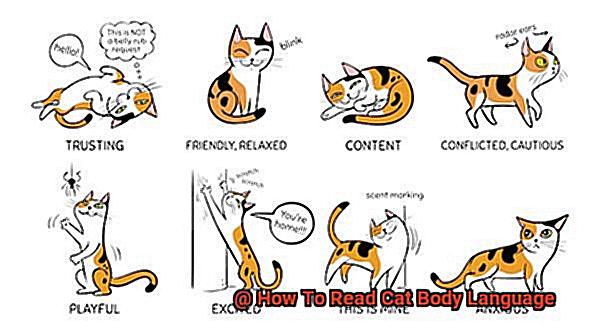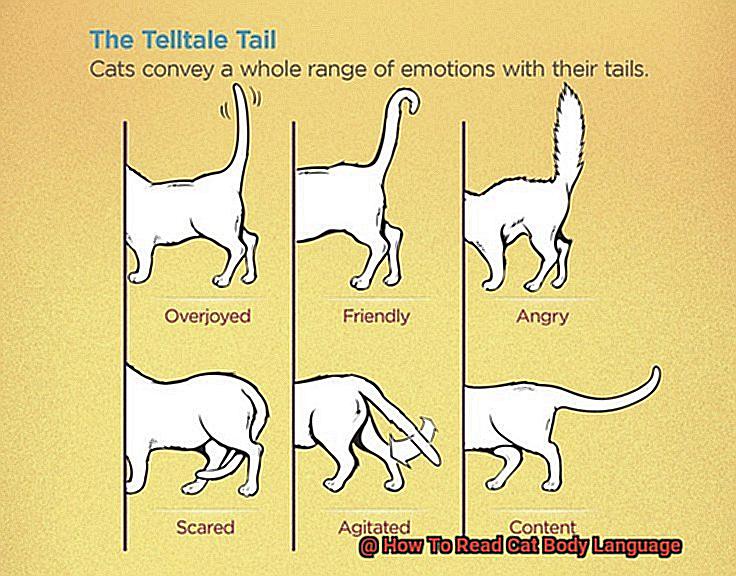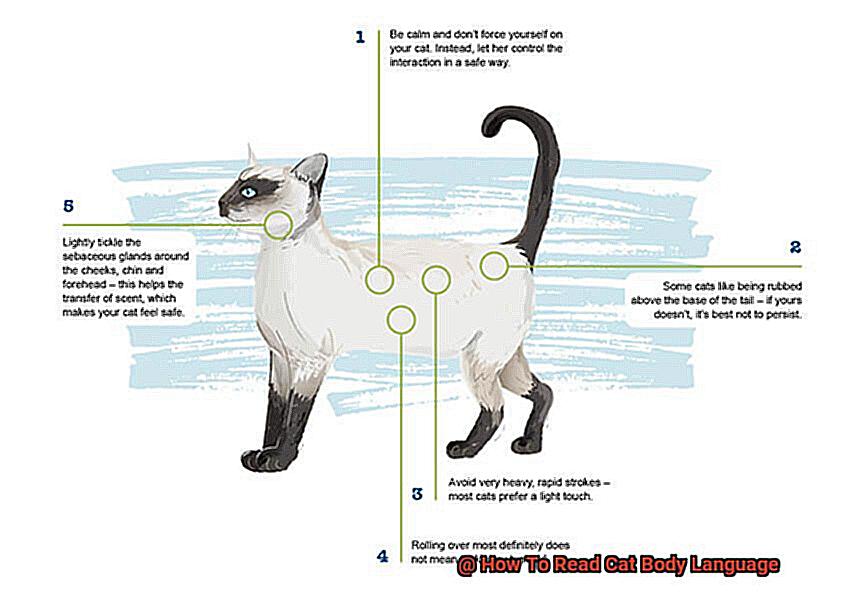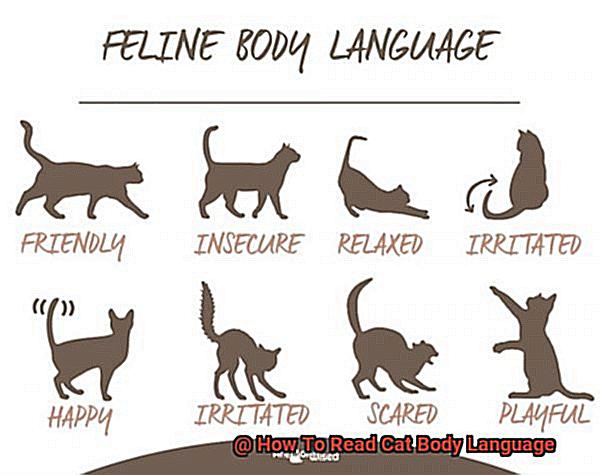Cats are enigmatic creatures, with a language all their own. But did you know that they communicate primarily through body language? By learning to read their nonverbal cues, you can gain insight into your feline companion’s thoughts and feelings, and strengthen the bond between you.
Have you ever wondered what your cat is trying to tell you when they arch their back or twitch their tail? These subtle movements are just some of the ways cats convey their emotions and needs. Each cat has a unique personality, preferences, and moods; understanding their body language is essential for providing them with proper care and attention.
In this blog post, we’ll explore the captivating world of how to read cat body language. We’ll delve into the different types of signals cats use to communicate, including facial expressions, ear and tail movement, and body posture. You’ll learn how to interpret these signals in various situations – whether your cat is happy or scared or experiencing pain.
Whether you’re a devoted cat owner looking to deepen your connection with your furry friend or simply an animal lover curious about feline behavior, this post will teach you how to decode your cat’s body language like a pro. So keep reading to enhance communication with your beloved pet.
Facial Expressions: Understanding Your Cat’s Moods
One way to understand your kitty’s moods is by reading their facial expressions. Just like humans, cats use their faces to convey how they’re feeling. By learning to read your cat’s expressions, you’ll be able to understand their needs and emotions better.
Have you ever noticed your cat giving you a “slow blink?” This is a sign that your cat feels comfortable and relaxed around you. It’s like a kitty kiss. When your feline companion blinks slowly and deliberately while making eye contact with you, it means they trust you and feel safe in your presence. So, next time your cat gives you a slow blink, remember that it’s their way of saying “I love you.”
However, if your cat’s back is puffed-up or arched, it’s a sign that they feel threatened or scared. They may also hiss or growl in this state. If you notice your cat displaying this behavior, it’s best to give them some space and avoid approaching them until they calm down.
A cat’s ears are also an essential indicator of their emotional state. If your cat’s ears are pointing forward or slightly to the side, it means they’re relaxed and contented. On the other hand, if their ears are flat against their head, it could indicate that they’re feeling scared or anxious.
Another clue to look out for is your cat’s pupils. If their pupils are dilated or their eyes are wide open, it could be a sign that they’re feeling stressed or frightened.
Overall, understanding your cat’s facial expressions is key to building a strong bond with them. By paying attention to their body language and knowing what they’re trying to communicate, you’ll be able to provide them with the care and attention they need. It’s like learning a new language. Once you start to understand what your cat is saying through their face, you’ll be able to communicate more effectively with them and deepen your bond.
Ear Positions: Reading Your Cat’s Emotions
Paying attention to your cat’s ear positions can give you valuable insights into what they’re feeling.
When your cat’s ears are pointing forward and slightly to the sides, it means they’re alert and curious. It’s like they’re on a mission to explore, discover and solve mysteries. This ear position is an excellent sign that your cat is happy, engaged, and enjoying their environment.
On the other hand, when your cat’s ears are flattened against their head, it’s a red flag that they’re scared, anxious or angry. It’s like they’re trying to shrink away from danger or blend in with their surroundings. In such situations, it’s vital to give your cat space and avoid anything that may scare them further.
Another ear position to watch out for is when your cat’s ears are pointing backward. This position usually indicates that your cat is defensive or aggressive. It’s like they’re saying, “Don’t mess with me.” The context in which this ear position occurs can give you clues on what your cat is trying to communicate.
In conclusion, decoding your cat’s ear positions can help you better understand their emotions and respond appropriately. However, keep in mind that each cat is unique and may have different ear positions for the same emotion. By observing your furry friend closely, you’ll learn their specific body language cues and strengthen the bond between you two.
Tail Positions: Interpreting Your Cat’s Feelings
By understanding the different tail positions and what they signify, you can gain insight into your cat’s emotions and needs.
If your cat’s tail is held high, it is likely feeling happy and confident. It’s like a flag waving proudly in the wind, signaling contentment and satisfaction. Conversely, if your cat tucks its tail between its legs, it is usually a sign of fear or anxiety. This is a clear indication that your kitty wants to withdraw from whatever is causing it distress.

A tail that twitches or lashes back and forth can be a sign of agitation or irritation. Your cat may be feeling threatened or frustrated, and its tail acts as a warning signal to keep away. Similarly, if your cat’s tail is puffed up, it may be trying to make itself look bigger to intimidate what it perceives as a threat.
When your cat’s tail is relaxed and gently swaying, it is likely feeling content and at ease. It’s like your feline friend is saying “life is good” with its tail. However, if its tail is curved around its body, this may indicate submission or fear.

It’s vital to remember that interpreting your cat’s tail positions requires attention to other body language cues. For instance, a high-held tail combined with flattened ears could indicate aggression rather than happiness.
By paying attention to your cat’s body language, including tail positions, you can foster a stronger bond with your furry companion by better understanding its needs and wants.

Vocalizations: Deciphering Your Cat’s Needs
Cats use a variety of vocalizations to express their needs and emotions, and deciphering these sounds is key to understanding your pet.
The most common sound cats make is the meow, which can mean different things depending on the tone and length. Short meows are usually greetings or requests for attention, while long meows may indicate hunger or discomfort. If your cat is repeatedly meowing, they could be trying to tell you something important, so it’s best to pay attention.
Another well-known sound is purring, which is often associated with contentment and relaxation. However, cats may also purr when they’re in pain or feeling stressed. So if your furry friend is purring at the vet’s office, it might not be because they’re happy to see you.
Growling and hissing are more aggressive sounds that cats use when they feel threatened or are trying to establish dominance. If your cat is growling or hissing at you or another pet, it’s best to give them some space and avoid provoking them further.
Lastly, yowling is a loud and sometimes unpleasant sound that cats make for various reasons such as territorial behavior or pain. If your cat is yowling excessively, it could be experiencing discomfort or anxiety and should be taken to the vet for evaluation.
Understanding your cat’s vocalizations is crucial for meeting their needs and strengthening your bond with them.
Overall Body Posture: Identifying Your Cat’s State of Mind
By understanding your cat’s overall body posture, you can learn a lot about their mood and intentions.
A relaxed body posture is a clear indication that your cat is happy and content. Their body will be loose and comfortable, with their ears in a normal position, and their tail relaxed or slightly curved. It’s like they’re saying, “Hey, life is good.”

However, if your cat’s back is arched and their fur is puffed up, they may be feeling threatened or defensive. This posture often comes with growling, hissing, or spitting as your cat tries to protect themselves from perceived danger. It’s like they’re saying, “Back off, I’m not in the mood.”
When your cat crouches low to the ground with their ears flattened against their head, they may be feeling scared or anxious. This posture is often seen when cats are afraid of something or someone. It’s like they’re saying, “I’m scared, please help me feel safe.”
A stiff body posture with a high and erect tail can indicate that your cat is feeling aggressive or ready to attack. This posture often comes with dilated pupils and hissing or growling. It’s important to give your cat space and avoid provoking them when they’re in this state. It’s like they’re saying, “I mean business, don’t mess with me.”
Finally, when your cat rolls over onto their back and exposes their belly, it can be a sign of trust and affection. This posture indicates that your cat feels safe and comfortable around you. It’s like they’re saying, “I trust you completely.”
Remember, observing your cat’s behavior over time will help you understand what different postures mean in different situations. By paying attention to your cat’s overall body posture, you’ll build a stronger bond with them and ensure their happiness and health.
Tips for Interpreting Cat Body Language
One moment they’re purring contentedly in your lap, and the next they’re giving you the cold shoulder. But did you know that cats communicate through body language just like humans do? By learning to read your cat’s body language, you can gain a deeper understanding of their moods and needs, thereby strengthening your bond with them.
Here are some tips to help you interpret your cat’s body language more effectively:
Tail position
The position of a cat’s tail can indicate its mood. A high-held tail signifies confidence and happiness, while a low-held tail indicates fear or submission. If your cat’s tail is twitching aggressively, it could be a sign of agitation.

Ear position
A cat’s ears can tell you a lot about their mood. Ears pointed forward indicate alertness or interest, while flattened ears indicate fear or aggression.
Pupil dilation: Pay attention to the size of your cat’s pupils. Dilated pupils can indicate excitement or fear.
Body posture
A relaxed and open body posture indicates contentment, while a tense or hunched-over posture suggests fear or aggression.
Vocalizations
Cats use different vocalizations to communicate their needs and emotions. Meows can indicate hunger or attention-seeking, while growls or hisses indicate fear or aggression.
Grooming behaviors
Cats often groom themselves when they are content and happy. Excessive grooming can indicate stress or illness.
Eye contact
Direct eye contact with a cat can be seen as a challenge or threat. Avoid staring directly at your cat for too long, as this can make them uncomfortable.
By paying attention to these subtle cues, you can better understand your cat’s needs and emotions, leading to a stronger and more positive relationship between you both.
But understanding your cat’s body language isn’t just about deciphering their moods. It’s also about respecting their boundaries and making them feel comfortable and safe.
For example, if your cat is hissing while backed into a corner, it’s likely they are scared and feel like they have no escape route. By recognizing this and giving them space, you can help alleviate their fear and build trust.
In addition, learning to read your cat’s body language can also help you identify potential health issues. For instance, excessive grooming can be a sign of stress, while a hunched-over posture could indicate pain or discomfort.
Common Misconceptions About Reading Cat Body Language
- Firstly, a wagging tail does not always mean a happy cat. Unlike dogs, cats often wag their tails when they’re annoyed or agitated. So next time you see your cat’s tail flicking back and forth, don’t assume everything is okay.
- Secondly, a purring cat is not always relaxed and content. Sure, cats often purr when they’re happy, but they can also purr when they’re anxious or in pain. So pay attention to other body language cues to understand what your cat is trying to communicate.
- Lastly, don’t assume that if your cat shows you their belly, they want a belly rub. While some may enjoy a good tummy rub, exposing their belly can also be a defensive posture meant to intimidate potential threats. Approach with caution and look for other signals before going in for a pat.
Remember that each cat has its unique personality and experiences, so learning to interpret their specific signals can help you understand their emotional state better.
Benefits of Understanding Cat Body Language
- First, understanding cat body language can help you build a stronger bond with your feline companion. When you interpret their movements and behaviors, you can respond appropriately and build trust with your pet. Just like how we use body language to communicate with others, cats do too. By learning to interpret their signals, you’ll be able to understand what they’re feeling or trying to tell you, leading to a happier home life.
- Secondly, cats are masters of subtle communication, often displaying signs of discomfort or anxiety that can be missed by an untrained eye. However, by understanding cat body language, you’ll be able to quickly identify when your cat is feeling stressed or uncomfortable. This means you can take steps to alleviate their discomfort, such as providing a calm environment or seeking veterinary attention if necessary.
- Lastly, understanding cat body language can also improve the overall health and well-being of your feline companion. Many feline behaviors such as excessive scratching or grooming can be indicative of an underlying health issue. By understanding these behaviors, you can take early action and ensure that your cat receives timely medical attention, leading to improved health and happiness.
Understanding cat body language is essential for any cat owner who wants to deepen their bond with their pet and ensure their health and well-being. Paying attention to the subtle signals your feline friend is sending you is the key to building a stronger relationship and creating a happier home for both you and your beloved pet. So why wait?
7MVmdYwUjk4″ >
Conclusion
To sum it up, being able to read your cat’s body language is essential for any cat owner who wants to strengthen their bond with their furry friend and ensure their overall health and well-being. By paying close attention to subtle cues such as facial expressions, ear and tail movements, vocalizations, and overall posture, you can gain a better understanding of your cat’s emotions and needs.
Understanding your cat’s body language can help you respond appropriately to their behaviors, which can ultimately lead to a stronger relationship with them. Additionally, being able to recognize when your cat is feeling stressed or uncomfortable can allow you to seek medical attention promptly if necessary.
It’s important to keep in mind that every cat is unique and has its own personality and experiences. Therefore, learning how to interpret your specific feline’s signals can help you understand their emotional state better.
By becoming fluent in your cat’s body language, you can build a deeper connection with them while also respecting their boundaries and ensuring they feel comfortable and safe.







